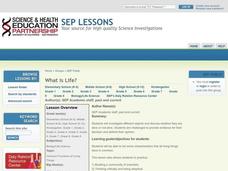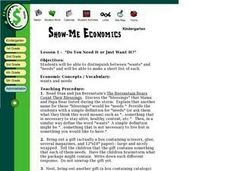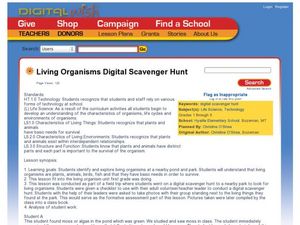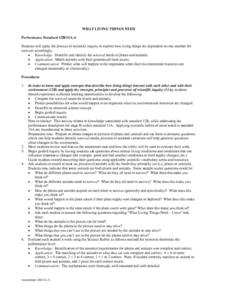Curated OER
Is It Alive?
First graders explore living things and their habitats. They create an original It's Alive! book to demonstrate what they have learned.
Curated OER
Investigating Local Ecosystems
Students investigate the habitats of local plants and animals. They explore some of the ways animals depend on plants and each other. Students observe living organisms in a local ecosystem and create detailed drawings and descriptions...
Curated OER
What is Life?
Students investigate the characteristics of living things. In this life science lesson, students examine several living and non-living specimens. Students determine which things are living and non-living.
Curated OER
Investigation 3 - Terrariums / Aquariums
Third graders create aquariums or terrariums to explain how creatures depend on living and nonliving things.
Curated OER
What Do Pets Need?
Students identify the needs that all humans and animals have. In groups, they play a game to discover the proper way to take care of pets. To end the lesson, they develop a plan to best take care of their pets at home and view pictures...
Curated OER
Reconstructing the Squares
Students visit an outdoors area and mark out a square on the ground that they examine, looking for living and non-living things. They make a model or drawing of the findings from the actual square.
Curated OER
Lesson Plan on Wants and Needs
First graders examine and discuss the difference between what they need to live and what they want. They examine pictures from magazines and newspaper ads, distinguishing between whether they are wants or needs.
Curated OER
The Web of Life
Students demonstrate the interrelationships of animals and plants. In this ecology lesson, students discuss the things plants and animals need for survival and study the glacier food chain. Students simulate the web of life by using a...
Curated OER
Hunters and Gatherers
Sixth graders participate in mapping and other activities to understand why ancient civilizations developed as they did. In this ancient civilization lesson, 6th graders recognize that there were three important climate zones and...
Curated OER
"Do You Need It or Just Want It?"
Students distinguish between "wants" and "needs." Students make a short list of each. They review The Berenstain Bears Count Their Blessings book and discuss what blessings are. Students then rewrite their list of wants and needs.
Curated OER
Who Needs My Help?
Students think about helping others. In this citizenship instructional activity, students think of people in their lives who could use their help. Students illustrate the things they do to help others.
Curated OER
The Internet of Things: IoT
How has the Internet of Things affected our lives? Scholars examine the massive influence of mobile devices in this analysis lesson, which begins with a seven-minute documentary clip. They also read a New York Times article (linked)...
Curated OER
The Characteristics of Living Things
Eighth graders explore the characteristics of living things. In this living things lesson plan, 8th graders review as a class the cell theory and the characteristics of living things. They answer questions about how to determine if...
Curated OER
Living Organisms Digital Scavenger Hunt
Students photograph living organisms. In this plan for a field trip, students go to a local park or pond and photograph themselves with various living organisms on their scavenger hunt list. The photographs taken are compiled into a...
Curated OER
What Living Things Need
Students apply the process of scientific inquiry to explore how living things are dependent on one another for survival. They match animals with their generalized food source. Students predict what happens to the organisms when their...
Alabama Learning Exchange
Nature's Life Cycle
Become a member of the Pollution Patrol and stand up to litter! After discussing the life cycle of seeds and discussing how plants figure into the food chain, young conservationists engage in several activities involving podcasts,...
Curated OER
Taming Wild Land
Third graders consider the habitat needs of living things and how extensive farming in an area can affect the plants and animals of a region. They participate in a simulation to show how changing the habitat in one area can greatly...
Curated OER
The Needs of Living Things
Students investigate the global food chain by creating a visual chart. For this ecology lesson, students discover the elements needed for life to sustain itself, contrasting living things vs. non living things. Students fill in a...
Curated OER
Pond Life
Students explore pond ecosystems. In this living environment lesson, students observe the local pond and identify the living things they find by drawing pictures. Students observe organisms that were found in the pond by using a...
Curated OER
Student Designed Investigations: Observations
Students choose an organism and create an experiment with that organism. In this observation instructional activity, students expose a living thing to something from its environment and record their observations. Students must have some...
Alabama Learning Exchange
Classification
Learners examine why scientists classify living organisms. They list and classify items they buy at the grocery store, sort and classify leaves, explore various websites, and write a biography of Carolus Linnaeus.
Baylor College
Air and Breathing
Blow some bubbles and learn how living things need air in the eighth lesson of this series. Young scientists investigate this important gas by observing bubbles and monitoring their own breathing. A simple and fun activity that raises...
Curated OER
Living and Non-Living
Fourth graders are divided into small groups and collect 4 objects from the playground. They take 5 to 10 minutes to classify their groups and discuss their findings including the terms "living" and "non-living". As a class they discuss...
Curated OER
Meeting our Basic Needs
Students brainstorm the basic needs of the community and create a chart. In this volunteerism lesson, students recognize people in the community who have given charity in the community. Students read biographies of these charitable...
























